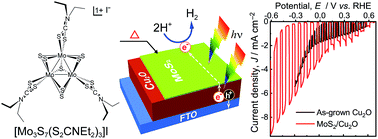当前位置:
X-MOL 学术
›
J. Mater. Chem. A
›
论文详情
Our official English website, www.x-mol.net, welcomes your feedback! (Note: you will need to create a separate account there.)
Synthesis of MoS2 from [Mo3S7(S2CNEt2)3]I for enhancing photoelectrochemical performance and stability of Cu2O photocathode toward efficient solar water splitting†
Journal of Materials Chemistry A ( IF 11.9 ) Pub Date : 2018-05-01 00:00:00 , DOI: 10.1039/c8ta01771a P. S. Shinde 1, 2, 3, 4, 5 , P. R. Fontenot 1, 4, 6, 7 , J. P. Donahue 1, 4, 6, 7 , J. L. Waters 2, 3, 4, 5, 8 , P. Kung 2, 3, 4, 5, 8 , L. E. McNamara 4, 9, 10, 11 , N. I. Hammer 4, 9, 10, 11 , A. Gupta 1, 2, 3, 4, 5 , S. Pan 1, 2, 3, 4, 5
Journal of Materials Chemistry A ( IF 11.9 ) Pub Date : 2018-05-01 00:00:00 , DOI: 10.1039/c8ta01771a P. S. Shinde 1, 2, 3, 4, 5 , P. R. Fontenot 1, 4, 6, 7 , J. P. Donahue 1, 4, 6, 7 , J. L. Waters 2, 3, 4, 5, 8 , P. Kung 2, 3, 4, 5, 8 , L. E. McNamara 4, 9, 10, 11 , N. I. Hammer 4, 9, 10, 11 , A. Gupta 1, 2, 3, 4, 5 , S. Pan 1, 2, 3, 4, 5
Affiliation

|
Cu2O is a typical p-type semiconductor that can efficiently absorb visible light and has a high absorption coefficient due to its narrow forbidden band. Thus, it finds potential applications in solar energy conversion and photocatalysis. However, Cu2O photocathodes suffer from a major issue of chemical stability and sluggish proton reduction for splitting water using sunlight. We present here a facile method of coating a thin MoS2 layer onto Cu2O to significantly improve its stability and proton reduction efficiency. MoS2 coating on top of Cu2O is achieved by spin coating a [Mo3S7(S2CNEt2)3]I precursor combined with a thermal annealing process to obtain the optimal stoichiometry. MoS2 thin films synthesized using this method show good prospects as both a protection layer and an electrocatalyst for hydrogen evolution reactions (HER) due to excellent stability and high electrocatalytic activity. The proton reduction performance of spin-coated MoS2/FTO electrodes is studied to determine the optimal synthesis conditions using various derivatives of MoS2 precursors. Our study suggests that the rate-limiting kinetic step of MoS2 synthesized in this method is the desorption of adsorbed hydrogen atoms to form molecular hydrogen, and that nanocrystalline MoS2 with copiously exposed S edges are more active for HER. Photoelectrochemical measurements demonstrate the highest activity for 3-layered (<40 nm thick) MoS2/Cu2O photocathode fabricated at 450 °C with a photocurrent density of ∼6.5 mA cm−2 at −0.2 V vs. RHE. Additionally, the MoS2 coating helps minimize the dark current of the Cu2O photocathode.
中文翻译:

由[Mo 3 S 7(S 2 CNEt 2)3 ] I 合成MoS 2,以增强Cu 2 O光电阴极的光电化学性能和稳定性,从而有效分解太阳能†
Cu 2 O是典型的p型半导体,由于禁带窄,因此可以有效吸收可见光并且具有高吸收系数。因此,它在太阳能转化和光催化中发现了潜在的应用。但是,Cu 2 O光阴极存在化学稳定性和质子减少的主要问题,该质子降低了利用阳光将水分解的质子。我们在这里提出一种在Cu 2 O上涂覆一层薄MoS 2层的方法,以显着提高其稳定性和减少质子的效率。的MoS 2的涂层对Cu顶部2 O由旋涂实现[沫3小号7(S 2 CNET 2)3 ] I前驱体与热退火工艺相结合以获得最佳化学计量。使用这种方法合成的MoS 2薄膜由于具有出色的稳定性和高电催化活性,因此既可以作为氢析出反应(HER)的保护层又可以用作电催化剂。研究了旋涂MoS 2 / FTO电极的质子还原性能,以确定使用MoS 2前驱体的各种衍生物的最佳合成条件。我们的研究表明,用这种方法合成的MoS 2的限速动力学步骤是吸附的氢原子解吸形成分子氢,而纳米晶MoS 2S边缘大量暴露的HER对HER更为活跃。光电化学测量结果表明,在450°C下制造的3层MoS 2 / Cu 2 O光电阴极(厚度小于40 nm)具有最高活性,在-0.2 V相对于RHE的光电流密度为6.5 mA cm -2。另外,MoS 2涂层有助于最小化Cu 2 O光电阴极的暗电流。
更新日期:2018-05-01
中文翻译:

由[Mo 3 S 7(S 2 CNEt 2)3 ] I 合成MoS 2,以增强Cu 2 O光电阴极的光电化学性能和稳定性,从而有效分解太阳能†
Cu 2 O是典型的p型半导体,由于禁带窄,因此可以有效吸收可见光并且具有高吸收系数。因此,它在太阳能转化和光催化中发现了潜在的应用。但是,Cu 2 O光阴极存在化学稳定性和质子减少的主要问题,该质子降低了利用阳光将水分解的质子。我们在这里提出一种在Cu 2 O上涂覆一层薄MoS 2层的方法,以显着提高其稳定性和减少质子的效率。的MoS 2的涂层对Cu顶部2 O由旋涂实现[沫3小号7(S 2 CNET 2)3 ] I前驱体与热退火工艺相结合以获得最佳化学计量。使用这种方法合成的MoS 2薄膜由于具有出色的稳定性和高电催化活性,因此既可以作为氢析出反应(HER)的保护层又可以用作电催化剂。研究了旋涂MoS 2 / FTO电极的质子还原性能,以确定使用MoS 2前驱体的各种衍生物的最佳合成条件。我们的研究表明,用这种方法合成的MoS 2的限速动力学步骤是吸附的氢原子解吸形成分子氢,而纳米晶MoS 2S边缘大量暴露的HER对HER更为活跃。光电化学测量结果表明,在450°C下制造的3层MoS 2 / Cu 2 O光电阴极(厚度小于40 nm)具有最高活性,在-0.2 V相对于RHE的光电流密度为6.5 mA cm -2。另外,MoS 2涂层有助于最小化Cu 2 O光电阴极的暗电流。



























 京公网安备 11010802027423号
京公网安备 11010802027423号